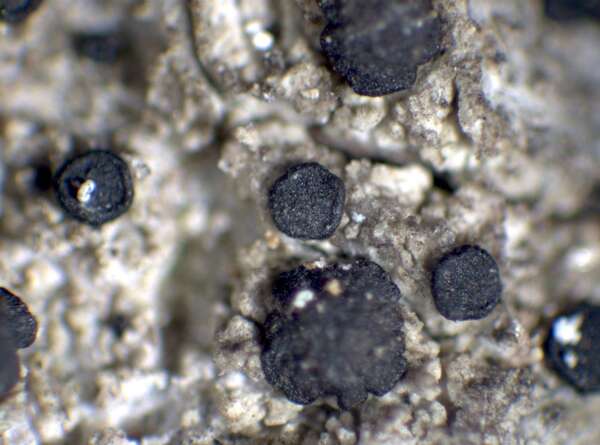Bellicidia incompta (Borrer) Kistenich, Timdal, Bendiksby & S.Ekman
Taxon, 67: 891, 2018.. Basionym: Lecidea incompta Borrer in Hooker & Sowerby - Engl. Bot., Suppl. 2, tab. 2699, 1831.
Synonyms: Bacidia atrosanguinea auct.; Bacidia incompta (Borrer) Anzi; Bacidia incompta (Borrer) Anzi; Bacidia subincompta (Nyl.) Arnold non auct.; Bacidia viridula Erichsen; Lecidea atrosanguinea auct. non (Hoffm.) Nyl.; Scoliciosporum molle A. Massal.; Toniniopsis subincompta (Nyl.) Kistenich, Timdal, Bendiksby & S. Ekman non auct.
Distribution: N - Ven (Lazzarin 2000b, Watson 2014), TAA (Dalla Torre & Sarnthein 1902, Nascimbene & al. 2022), Lomb, Piem (Isocrono & al. 2004). C - Tosc, Sar (Zedda 2002, 2002b, Rizzi & al. 2011, Di Nuzzo & al. 2022). S - Camp (Aprile & al. 2003b, Garofalo & al. 2010), Pugl (Nimis & Tretiach 1999), Bas (Bartoli & Puntillo 1998), Cal (Puntillo 1996, Puntillo & Puntillo 2004).
Description: Thallus crustose, mostly episubstratic, grey-green, grey-brown or grey-white, granular-verrucose. Apothecia lecideine, (0.2-)0.3-0.8(-1) mm across, sessile an constricted at base, dark purple-brown to black, with a flat to slightly convex disc and a thin, persistent, often slightly paler proper margin. Proper exciple hyphal in construction, with globose outer cells, dark red-brown, K+ purple, the outermost part sometimes colourless; epithecium colourless to reddish, K-; hymenium colourless or pale red in upper part, 35-55 μm high, I+ blue; paraphyses 1.5-2 (-2.5) μm thick simple or rarely forked in upper part, the apical cells up to c. 3 μm wide; hypothecium dark red-brown, K+ purple. Asci 8-spored, clavate, the apical dome K/I+ dark blue with a pale, conical-pointed apical cushion (axial mass), the wall I-, but the thin outer gel I+ blue, Bacidia-type. Ascospores (1-)3(-5)-septate, hyaline, elongate-bacilliform to cylindrical, 15-25(-27) x 2-3 μm, fasciculate in the asci. Pycnidia small, semi-immersed, with thin, red-brown, K+ purple walls. Conidia cylindrical-ellipsoid, 0-1-septate, 5-9 x 2-2.5 μm. Photobiont chlorococcoid, the cells globose, 5-12(-14) μm in diam. Spot tests: thallus K-, C-, KC-, P-, UV-. Chemistry: thallus without lichen substances.Note: a temperate species found on base-rich bark, especially of Ulmus, near wounds of the trunk, more rarely on plant debris and terricolous mosses, certainly declining in Italy. It is included in the Italian red list of epiphytic lichens as “Vulnerable” (Nascimbene & al. 2013c).
Growth form: Crustose
Substrata: bark, soil, terricolous mosses, and plant debris
Photobiont: green algae other than Trentepohlia
Reproductive strategy: mainly sexual
Commonnes-rarity: (info)
Alpine belt: absent
Subalpine belt: absent
Oromediterranean belt: absent
Montane belt: extremely rare
Submediterranean belt: extremely rare
Padanian area: absent
Humid submediterranean belt: very rare
Humid mediterranean belt: absent
Dry mediterranean belt: absent

Predictive model
Herbarium samples
Growth form: Crustose
Substrata: bark, soil, terricolous mosses, and plant debris
Photobiont: green algae other than Trentepohlia
Reproductive strategy: mainly sexual
Commonnes-rarity: (info)
Alpine belt: absent
Subalpine belt: absent
Oromediterranean belt: absent
Montane belt: extremely rare
Submediterranean belt: extremely rare
Padanian area: absent
Humid submediterranean belt: very rare
Humid mediterranean belt: absent
Dry mediterranean belt: absent

Predictive model
| Herbarium samples |
 Index Fungorum
Index Fungorum
 GBIF
GBIF



